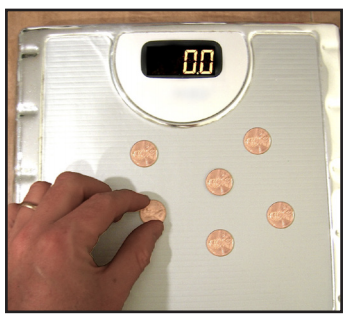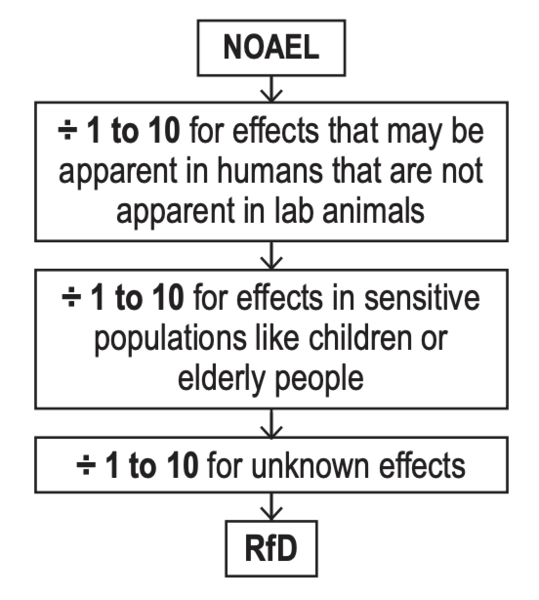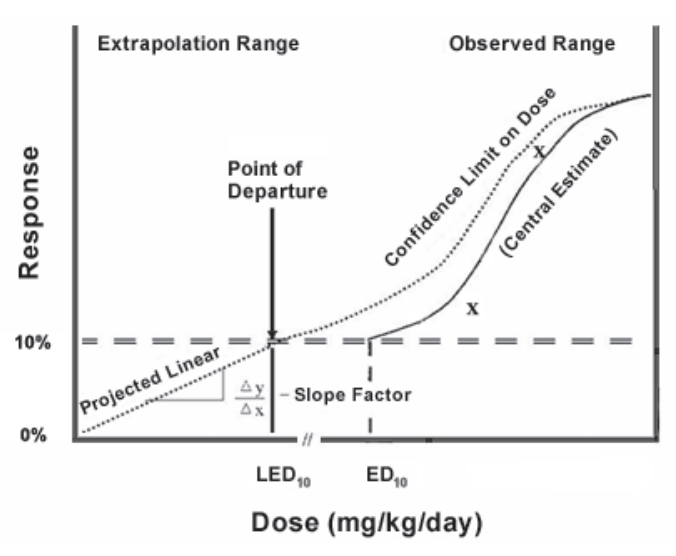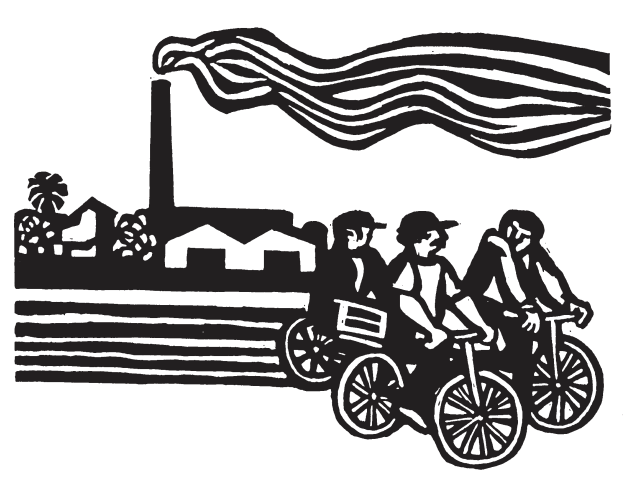Adapted from the Statistics for Action Air Quality Unit "Limits and Levels" and generously shared with permission. You can access a printable version of this guide at sfa.terc.edu
Overview
Environmental advocates see many kinds of limits and levels. What are these limits? If a test result exceeds one of them, are there implications for health or legal liability? This resource has fact sheets for limits and levels you might read or hear about. Each tells you what the limit is, how it’s used, how it’s determined, and how it relates to health. Most of the fact sheets also list a web site with more information.
Many states have health-based standards that are more restrictive than the federal standards. The states may call those standards by different names. If you want to use the conservative standards, check both federal and state regulations, and choose the limit you prefer. Many fact sheets refer to units like mg/kg, ppm, and µg/m3. For help understanding these units, see the fact sheets in the resource Common Units.
| Fact Sheet | Soil | Water | Air | Health-Based Standard |
|---|---|---|---|---|
| Detection Limits | Y | Y | Y | |
| Reporting Limits* | Y | Y | Y | |
| Background Levels* | Y | Y | Y | |
| Reference Dose | Y | Y | Y | |
| Cancer Slope Factor and Unit Risk Factor | Y | Y | Y | Y |
| Maximum Contaminant Levels (MCLs)* | Y | Y | ||
| Groundwater Objectives (GWOs)* | Y | Y | ||
| Screening Quick Reference Tables(SQuiRTs) | ~ | Y | ~ | |
| Residential and Industrial Soil Screening Levels(RSSLs and ISSLs) | Y | Y | ||
| National Ambient Air Quality Standards (NAAQS)* | Y | Y | ||
| Reference Concentration (RfC) for Inhalation | Y | Y | ||
| Occupational Safety and Health Administration* | ~ | Y | ~ |
“Y” means “Yes”
“~” means “more complicated than yes or no.” See the fact sheet for the full story
Detection Limits and Quantitation Limits
What are they? Every measuring device has limits. If you put one penny on a digital bathroom scale, the scale still reads zero. If you keep adding pennies, you eventually see a number at 0.1 lb (one tenth of a pound). That means 0.1 lb is the detection limit for that scale. Anything less is not detected. Tests for air, water, and soil contamination methods also have detection limits, below which a contaminant can’t be detected. They also have quantitation limits, below which they can detect a contaminant, but the amount can’t be accurately measured (“quantified”)

Image: Pennies on a scale
How are they used? Detection and quantitation limits are called by different names on test results:
instrument detection limit (IDL)
method detection limit (MDL)
practical quantitation limit (PQL)
limit of quantification (LOQ)
minimum quantitation limit (MQL)
When test results are below detection limits, you may see ND, meaning “Not Detected” or U (“Under the detection limit”) or an * or < symbol. In each case, there should be a note somewhere on the page showing the detection limit. Sometimes the number will appear in the results themselves, like “<5,” meaning “less than five."

Image: Sample chart showing detection limits. Here, for each testing date the results appear next to a "Limit." But this isn't a legal limit, it's the detection limit. Notice how the detection limit changes each month as the lab tries to find a limit that will detect the contamination, but won't be far more sensitive than is needed.
How are they determined? Detection limits are determined by the equipment and methods used for testing. A lab should choose equipment and methods that will detect contamination well below health-based standards. If 50 µg/L might be hazardous, but the the detection limit is 100 µg/L, then a “not detected” won’t tell you whether or not you’re at risk. It’s better to set detection limits at 5 µg/L, one-tenth the level of concern. However, very sensitive tests are expensive, and not always necessary. If the screening level is 5,000 µg/kg, you don’t need a test that can find as little as 1 µg/kg. Also, a very sensitive instrument might not work for high levels of contamination – your bathroom scale wouldn’t work to weigh an elephant or a truck!
How are they related to human health? Detection limits aren’t directly related to health or safety. If you have test results, it’s more important to compare levels to a health based standard, like a screening level or legal limit. Detection limits are only a problem if they’re set too high, and risky results are undetectable.
Reporting Limits

Image: People at a table discussing reporting limits
What are they? In cases where testing has been mandated by a government agency, the agency may require contamination above a certain level to be reported, even if it is below the level of concern.
How are they used? Laboratories must use equipment and procedures that are capable of detecting contamination as low as the reporting limit. Sometimes tests show contamination above a reporting limit, but below a health-based standard. In those cases, a community might want to test nearby, to see if there is a contamination ‘hot spot’ they might have missed.
How are they determined? The reporting limits may be set at a particular fraction of the level of concern. For example, if the legal limit for a contaminant is 20 µg/L, the agency might set the reporting limit at 2 µg/L, which is one-tenth the level of the limit. That way, they will know if contamination is anywhere close to the legal limit.
How are they related to human health? Contamination levels over the reporting limit aren’t a health concern, unless the levels also go over a health-based standard.
Background Levels
What are they? Background levels (usually measured in soil) are the levels of contaminants that you might normally expect to find in a place, but that can’t be attributed to a single polluting source. Some toxins may be in the soil because they are naturally occurring, like arsenic or uranium. Others may be due to widespread human use – for example, lead from car exhaust in the mid-20th century spread widely in soil and water. Background levels vary from place to place.
For air and water, different terms may be used for the same idea. Scientists may say “ambient air quality” to mean a background level of outdoor air quality when comparing with contaminated indoor air. But this can be confusing, because there are also ambient air quality standards (see NAAQS) that have nothing to do with background levels.
How are they used? Comparing a test result to background levels helps show how unusual a test result is. If a test result is significantly above background levels, there might be a specific human cause for the contamination. Showing unusually high test results can help determine legal liability for cleanup costs or shutdowns.
How are they determined? Background levels are determined by testing over a very large area, like a whole county or state. The background level is often set at a value like the 90th percentile (meaning 90% of the samples were below that level, so it would be unusual to find a sample above that level). Sometimes the background level is simply the average of all the samples.
How are they related to human health? Background levels and ambient air quality are determined by measurements, not by safety. A test result for a toxin that is close to the ‘normal’ background level might still be a health concern, if the background level is very high. On the other hand, if the background level is very low, a test result might be above background levels but might not be a health concern. For health risk insights, compare test results to health-based standards, not to background levels.

Image: This map reflects background levels of arsenic in Massachusetts well water. A high arsenic level in a private well in Groton might not be unusual, because it could be from the high background level. But the same level in Plymouth would be unusual, so it might be easier to prove it came from a specific business. In either place, you should avoid drinking contaminated water.
Reference Dose (RfD)
What are they? RfD is the amount of a substance, per unit of body weight, that a person could consume every day for their rest of their life with no increased likelihood of negative health effects. RfDs are measured in mg/ kg/day – milligram of toxin per kilogram of body weight per day. (Note: RfDs do not address cancer risks; there is no ‘safe’ level for a cancer-causing toxin. See Cancer Slope Factor for more.)
How are they used? RfDs are not legally binding by themselves, but they are the “building blocks” of almost all risk assessment. Health-based standards should be set so that a person with typical daily exposure won’t get more than the RfD of the contaminant. For example, a toxicologist knows a typical (154-lb) person drinks 2 - 4 liters of water per day. They might set the MCL for a toxin in drinking water so someone drinking that water would not exceed the reference dose.
Another example: A risk assessor focused on risks from contaminated soil might see if anyone’s exposure to that soil might lead to them absorbing more than the RfD of a toxin. Risk assessors also look at multiple paths of exposure: If someone is exposed to a toxin through the soil, water, and air, do all of those exposures add up to exceed the RfD?
A risk assessor might find that the level of contamination in a particular case is unlikely to be harmful even if it exceeds a particular standard. If exposure is less than typical (people rarely drink this water or come into contact with this soil) then there is less risk of exceeding the RfD.
How are they determined? RfDs are based on tests of laboratory animals. Sometimes they are based on human health studies from accidental exposure. Scientists start with a level of the toxin that has shown no observable negative effects (NOEL/NOAEL), or the lowest level of the toxin that has shown negative effects (LOEL/LOAEL) in lab animals. They then make that number smaller by safety factors:

Image: Safety factors
In this way, an RfD may end up being 1,000 times smaller than a NOAEL.
How are they related to human health? RfDs are set based on health risks, and are intended to be very conservative. They assume a lifetime of daily exposure at the RfD, so exposure slightly above the RfD for a short time is unlikely to increase health risks. Again, RfDs are for non-cancer effects. See Cancer Slope Factor.
For more information: Visit https://www.epa.gov/iris
Cancer Slope Factor and Unit Risk Factor
What are they? A cancer slope factor gives the percent increase in the risk of getting cancer associated with a dose of a toxin (in mg of toxin per kg of body weight) every day for a lifetime.
A unit risk factor is based on the slope factor, but is specific to air (and sometimes water). The inhalation unit risk factor answers, “How many more cancer cases per million people would I expect to see for every microgram of this toxin per cubic meter of air?” For water, it’s for every microgram of toxin per liter of drinking water.
How are they used? A risk assessor will apply cancer slope factors and unit risks to test results to calculate how many more cancer cases a population might be likely to see if that population had a lifetime of exposure to that amount of a toxin. Slope factor is general, while unit risk is specific to air or water.
How are they determined? Cancer slope factors and unit risks are usually based on tests on laboratory animals. Sometimes (but rarely) they are based on human health studies from accidental exposure. Calculations for people assume a 70-kg adult, exposed to the toxin for 70 years by breathing 20 m3 of air (or drinking 2 L of water) per day.
How are they related to human health? There are no ‘safe’ levels for carcinogens, because damage to a single cell can cause cancer. However, lower levels of a carcinogen will cause fewer additional cancer cases. If studies show that a certain level of a carcinogen isn’t likely to cause one new cancer case out of one million people, officials may decide that it is ‘acceptable’, even if it is not technically risk-free.

Image: Chart showing cancer slope factor. Scientists look at data from experiments and find the relationship between the dose (how much toxin is consumed) and the response (health effects). If they know what dose affects one in ten lab animals, and what dose affects one in a hundred lab animals, they can calculate the dose that would affect one in a million.
For more information: Visit https://www.epa.gov/iris
Maximum Contaminant Levels (MCLs) & MCL Goals (MCLGs)

Image: Drinking water from a tap
What are they? The EPA publishes maximum contaminant levels (MCLs) for different toxins in drinking water. MCLs are measured in milligram (mg) or microgram (µg) of contaminant per liter (L) of water.
How are they used? MCLs have legal weight. Public water systems are required to keep contamination below MCLs. If a business has contaminated private drinking water wells above the MCLs, the company may be liable for damages, health care costs, and cleanup costs.
How are they determined? MCL Goals (MCLGs) reflect ‘safe’ levels as closely as toxicologists can determine: if you drink this water every day for your entire life, you will not be any more likely to experience ill effects than if you didn’t drink that water. See Reference Dose for more on the science of how MCLs are set. For carcinogenic (cancer-causing) contaminants, there is no safe level, and so the MCLG is zero.
Unfortunately, achieving a zero (or extremely low) level is not always physically or politically possible. So MCLGs are ideal, but not legally binding. Regulators then set the MCL, which is legally binding, “as close to the MCLG as feasible, using the best available treatment technology and taking cost into consideration.”
How are they related to human health? MCLs are are a legal guideline, but they aren’t a dividing line between ‘safe’ and ‘unsafe’. The MCLGs offer the best protection of health. Some states, tribal groups, and European countries have more protective standards.
Remember that both MCLs and MCLGs are set assuming a lifetime of exposure. If contamination is only slightly over the MCLG, drinking one glass of it is unlikely to harm you. MCLs are most protective of human health in that they allow government agencies to take action to reduce contamination.

Image: MCLG and MCL for antinomy and arsenic
More Information Visit https://www.epa.gov/dwreginfo/drinking-water-regulations or your state's environmental agency website.
Groundwater Objectives (GWOs) and Preventive Action Limits (PALs)
What are they? GWOs are legal standards set by states for underground water. PALs are based on GWOs, and trigger action to prevent contamination from exceeding the GWO. GWOs and PALs may have different names in different states.
How are they used? Groundwater objectives are legally binding. A business found to be contaminating groundwater beyond a GWO can be shut down. If contamination exceeds a PAL, a business must take action to prevent further contamination, like reducing emissions or slowing production. PALs don’t trigger a shutdown, but they can serve as a serious warning that something needs to change.

Image: Groundwater objective and preventive action limits in Rhode Island
How are they determined? GWOs are set to be protective of people and ecologies for a variety of uses. For example, in Massachusetts there are 3 GWO categories, each with its own objectives:
| GW-1:. Strongest standards, for groundwater that could be used for drinking water |
| GW-2:. Meant to limit contamination from evaporating out of shallow groundwater and going into the air in a nearby building |
| GW-3:. Minimum standards that apply to all groundwater in the state |
Preventive Action Limits are based on the groundwater objectives – often set at one half or one tenth of the GWOs.
How are they related to human health? GWOs are set to be protective of human and ecological health. The set levels are based on assumptions about typical behavior. People with much more (or much less) contact with groundwater should keep exposure in mind when assessing a particular situation.
Screening Quick Reference Tables (SQuirRTs)
What are they? These tables contain a range of levels, all relating to potential damage to aquatic life (tiny animals living in water) from different levels of contamination in surface water (rivers, ponds, bays, etc.) and sediment.
How are they used? Like other screening levels, they are not legally binding. They are used as a quick comparison to measure the severity of contamination, and potential ecosystem effects.
How are they determined? The levels are set by the National Oceanic and Atmospheric Administration (NOAA). There are levels for “No Observable Adverse Effects Level (NOAEL)” all the way to “Severe Effects Level (SEL)”. These levels are set based on lab experiments and tests of actual contaminated bodies of water. One of the most common levels used is the “Threshold Effects Level (TEL)” which is the lowest level of contamination thought to harm aquatic life.
How are they related to human health? SQuiRT levels are set based on ecological health, not human health. However, if a test result shows very high levels compared to a severe SQuiRT level, be careful around that body of water. You will want to see results from additional tests before swimming, drinking nearby well water, or eating fish from the contaminated water.

Image: Screening Quick Reference Table for Inorganics in Sediment
More Information: Visit https://response.restoration.noaa.gov/environmental-restoration/environmental-assessment-tools
Residential and Industrial Soil Screening Levels (RSSLs and ISSLs)
What are they? Screening is a first pass at soil testing. Investigators try to locate contamination at a site, and to see how much there is. In EPA language, this is “Phase II” or “site characterization.” Investigators compare test results to EPA Region III Soil Screening Levels to determine how concerned they should be about the contamination. SSLs are measured in milligram of the toxin per kilogram of soil (mg/kg) which is the same as parts per million (ppm). Smaller amounts are measured in micrograms per kilogram (µg/kg), the same as parts per billion (ppb).
How are they used? Screening levels are widely used as a point of reference for various contaminants. There are different screening levels for residential and industrial use. If contamination in a sample exceeds a screening level, it is cause for concern, but it does not automatically mean that people are in danger or that a cleanup is legally required. It usually means there should be more testing in that area, to get details about the contamination, and about current and planned uses for the site.
How are they determined? SSLs are based on two factors: the relative toxicity of the contaminant, and on “typical” human exposure to soil. Residential levels (RSSIs) are set lower than Industrial levels (ISSLs), because people spend more time at home than at work, and because the most vulnerable populations (children and the elderly) are not often exposed to industrial settings. Workers in industrial settings can also be required to wear protective clothing if there is contamination.
How are they related to human health? Screening levels are based on “typical” exposures, but in reality, people have a wide range of contact with soil. If test results are above screening levels, a risk assessor should study how people might come into contact with that soil, and assess risk of exposure.

Image: Screening level calculations for different types of use
For more information: Visit https://www.epa.gov
National Ambient Air Quality Standards (NAAQS) for Criteria Air Pollutants (CAPs) and Air Quality Index (AQI)
What are they? NAAQS regulate six CAPs considered harmful to public health and the environment:
ground-level ozone (O3)
particulate matter (PM)
carbon monoxide (CO)
sulfur dioxide (SO2)
nitrogen dioxide (NO2)
lead (Pb)
There are two types of standards for each CAP. Primary standards provide public health protection. Secondary standards protect community assets beyond public health. AQI is scale that gives a quick sense of a day’s air quality based on five CAPs (all except lead).
How are they used? States measure air quality, particularly in urban areas, and compare to NAAQS. Places where air contamination exceeds one or more standards are called “non-attainment” areas. In those areas, states must have a plan describing how they will try to improve air quality.
AQI is a scale ranging from 0-500; a lower AQI is safer. An AQI of 100 corresponds to the primary standard for each CAP. As air quality changes on a daily or even hourly basis, the AQI can tell you how clean or polluted your air is and associated health effects. If you hear a warning on the radio about a hazardous air quality forecast, it’s based on the AQI.
How are they determined? Primary NAAQS are intended to protect public health, including protecting the health of sensitive populations like asthmatics, children, and the elderly.Secondary standards provide public welfare protection, including protection against decreased visibility and damage to animals, crops, vegetation, and buildings.
The AQI at a particular moment is based on air sampling. It’s based on how close each of five CAPs is to its standard, with 100 representing the standard. It’s weighted more heavily toward the most hazardous pollutants.
How are they related to human health? Primary NAAQS and AQI are meant to protect human health. Small or temporary exceedances might affect sensitive people. High or long-term exceedances may harm many people.

Image: Daily Peak AQI for PM2.5 and O3
Reference Concentration (RfC) for Inhalation

Image: People biking near a factory
What are they? RfC is a concentration of a toxin in the air that is unlikely to cause non-cancer health problems, even if a person breathes air with that concentration for an entire lifetime. It is usually measured in mg/m3 or µg/m3.
How are they used? RfCs are not legally binding, but they can be used as a guide for assessing risk. RfCs are also not as widely monitored and enforced as the NAAQS.
How are they determined? RfCs are usually based on tests on laboratory animals. Sometimes they are based on human health studies from accidental exposure.
How are they related to human health? Air contamination below RfCs is unlikely to cause health problems, even in the most sensitive people. As contamination goes higher above the RfC, the more likely it is to cause problems.
RfCs are only set for non-cancer effects. If an air toxin is a carcinogen, there is no ‘safe’ level. See Cancer Slope Factor.
For more information: Visit https://www.epa.gov/iris
Except for NAAQS, states regulate air quality more directly than the EPA. California lists their RfCs (calling them Reference Exposure Levels, or RELs) at: oehha.ca.gov/air/allrels.html
Use these, or your own state’s standards if the EPA lists no RfC.
Occupational Safety and Health Administration Permissible Exposure Limits (OSHA PELs)
What are they? PELs are regulatory limits on the amount or concentration of a substance in the air in a workplace. There are also some PELs for skin exposure to workplace contaminants. Most PELs apply to industry in general, though some are specific to shipyard employment and the construction industry.
How are they used? Most OSHA PELs apply to the average level of air contamination over an 8-hour period in a workplace. This is called an “8-hour time weighted average (TWA).” There are also short-term exposure limits based on 15-minute periods, and ceiling limits that should never be exceeded. If a business exceeds a PEL, they can be fined. If they exceed PELs regularly, they can be shut down.
How were they determined? The American Conference of Governmental Industrial Hygienists (ACGIH) regularly publishes a set of guidelines called Threshold Limit Values (TLVs®). In 1972, OSHA adopted the TLVs as official PELs. Even though the TLVs have continued to be updated since then, only a few PELs have been changed in that time. Most PELs have not. Changes have been proposed in the past, but have been blocked in the regulatory process.
How are they related to human health? The TLV guidelines were theoretically related to human health, but were not originally intended to be hard limits determining safety. PELs are widely criticized by environmental scientists and regulators for being based on outdated science. Many PELs would fail a modern EPA risk assessment. PELs should not be considered protective of human health.
For more information. Visit osha.gov/law-regs.html or check your state’s labor law enforcement agency website.
Originally published by TERC in 2014 with support from the National Science Foundation and shared with permission. Any materials posted on Public Lab are not endorsed by TERC or NSF and do not necessarily represent the views of either organization. Images courtesy of the Rini Templeton estate.
1 Comments
Thank you for explaining all this @kgradow1m by bringing the TERC 2014 documentation back to life ! This is amazing.
Reply to this comment...
Log in to comment
Login to comment.